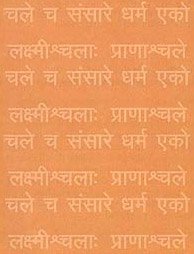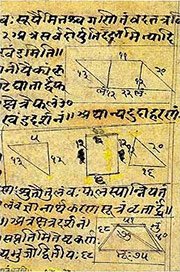Yugala: 16 definitions
Introduction:
Yugala means something in Hinduism, Sanskrit, Buddhism, Pali, the history of ancient India. If you want to know the exact meaning, history, etymology or English translation of this term then check out the descriptions on this page. Add your comment or reference to a book if you want to contribute to this summary article.
In Hinduism
Vedanta (school of philosophy)
Source: Shodhganga: Siva Gita A Critical StudyYugala (युगल) or Yugalagītā refers to one of the sixty-four Gītās commonly referred to in Hindu scriptures.—Gītā is the name given to certain sacred writings in verse (often in the form of a dialogue) which are devoted to the exposition of particular religious and theosophical doctrines. Most of these Gītās [i.e., Yugala-gītā] originate from the Mahābhārata or the various Purāṇas.

Vedanta (वेदान्त, vedānta) refers to a school of orthodox Hindu philosophy (astika), drawing its subject-matter from the Upanishads. There are a number of sub-schools of Vedanta, however all of them expound on the basic teaching of the ultimate reality (brahman) and liberation (moksha) of the individual soul (atman).
Ganitashastra (Mathematics and Algebra)
Source: archive.org: Hindu MathematicsYugala (युगल) represents the number 2 (two) in the “word-numeral system” (bhūtasaṃkhyā), which was used in Sanskrit texts dealing with astronomy, mathematics, metrics, as well as in the dates of inscriptions and manuscripts in ancient Indian literature.—A system of expressing numbers by means of words arranged as in the place-value notation was developed and perfected in India in the early centuries of the Christian era. In this system the numerals [e.g., 2—yugala] are expressed by names of things, beings or concepts, which, naturally or in accordance with the teaching of the Śāstras, connote numbers.

Ganitashastra (शिल्पशास्त्र, gaṇitaśāstra) refers to the ancient Indian science of mathematics, algebra, number theory, arithmetic, etc. Closely allied with astronomy, both were commonly taught and studied in universities, even since the 1st millennium BCE. Ganita-shastra also includes ritualistic math-books such as the Shulba-sutras.
Purana and Itihasa (epic history)
Source: archive.org: Shiva Purana - English TranslationYugala (युगल) refers to a “pair” (i.e., husband and wife), according to the Śivapurāṇa 2.3.45 (“Śiva’s comely form and the Jubilation of the Citizens”).—Accordingly, after Menā spoke to Śiva: “Delighted on seeing Śiva and overwhelmed by affection they cherished the comely form in their hearts and spoke as follows:—[The ladies said:—] ‘[...] Pārvatī has accomplished everything inasmuch as she performed penance for Śiva. She is blessed, she is contented in securing Śiva as her husband. If Brahmā had not joined this pair (yugala), Śiva and Śivā, his endeavour of creation would have entirely become fruitless. [...]’”.

The Purana (पुराण, purāṇas) refers to Sanskrit literature preserving ancient India’s vast cultural history, including historical legends, religious ceremonies, various arts and sciences. The eighteen mahapuranas total over 400,000 shlokas (metrical couplets) and date to at least several centuries BCE.
India history and geography
Source: Cologne Digital Sanskrit Dictionaries: Indian Epigraphical GlossaryYugala.—(IE 7-1-2), ‘two’. Note: yugala is defined in the “Indian epigraphical glossary” as it can be found on ancient inscriptions commonly written in Sanskrit, Prakrit or Dravidian languages.

The history of India traces the identification of countries, villages, towns and other regions of India, as well as mythology, zoology, royal dynasties, rulers, tribes, local festivities and traditions and regional languages. Ancient India enjoyed religious freedom and encourages the path of Dharma, a concept common to Buddhism, Hinduism, and Jainism.
Languages of India and abroad
Pali-English dictionary
Source: BuddhaSasana: Concise Pali-English Dictionaryyugala : (nt.) a pair or couple.
Source: Sutta: The Pali Text Society's Pali-English DictionaryYugala, & Yugaḷa (nt.) (Class. Sk. yugala; in relation to yuga the same as Lat. jugulum (“yoke-bone”) to jugum. Cp. also Gr. zeu/glh yoking strap) a pair, couple J. I, 12 (yugaḷa-yugaḷa-bhūtā in pairs), 500 (bāhu°); VI, 270 (thana° the 2 breasts); Vism. 219; VbhA. 51 (yugaḷato jointly, in pairs); the six “pairs of adaptabilities” or “words, ” Yog. 18—23, Mystic 30 sq.; cp. Dhs. 40 sq. Also used as adj. (like yuga) in phrase yugalaṃ karoti to couple, join, unite Dpvs. I, 77; VvA. 233. (Page 556)

Pali is the language of the Tipiṭaka, which is the sacred canon of Theravāda Buddhism and contains much of the Buddha’s speech. Closeley related to Sanskrit, both languages are used interchangeably between religions.
Sanskrit dictionary
Source: DDSA: The practical Sanskrit-English dictionaryYugala (युगल).—A pair, couple; बाहु°, हस्त°, चरण° (bāhu°, hasta°, caraṇa°) &c.
Derivable forms: yugalam (युगलम्).
Source: Cologne Digital Sanskrit Dictionaries: Shabda-Sagara Sanskrit-English DictionaryYugala (युगल).—n.
(-laṃ) A pair, a brace, a couple. E. yuga a pair, lac aff.
Source: Cologne Digital Sanskrit Dictionaries: Benfey Sanskrit-English DictionaryYugala (युगल).—[yuga + la], n. A pair, [Pañcatantra] 184, 16.
Source: Cologne Digital Sanskrit Dictionaries: Cappeller Sanskrit-English DictionaryYugala (युगल).—[masculine] [neuter] pair, couple.
Source: Cologne Digital Sanskrit Dictionaries: Monier-Williams Sanskrit-English Dictionary1) Yugala (युगल):—[from yuj] n. (rarely m.; ifc. f(ā). ) a pair, couple, brace, [Kāvya literature; Purāṇa; Pañcatantra] etc. (lo-√bhū, to be yoked or united with)
2) [v.s. ...] ‘double prayer’, Name of a prayer to Lakṣmī and Nārāyaṇa, [cf. Lexicographers, esp. such as amarasiṃha, halāyudha, hemacandra, etc.]
Source: Cologne Digital Sanskrit Dictionaries: Yates Sanskrit-English DictionaryYugala (युगल):—(laṃ) 1. n. A pair, a couple.
Source: DDSA: Paia-sadda-mahannavo; a comprehensive Prakrit Hindi dictionary (S)Yugala (युगल) in the Sanskrit language is related to the Prakrit words: Juala, Jugala.
[Sanskrit to German]
Sanskrit, also spelled संस्कृतम् (saṃskṛtam), is an ancient language of India commonly seen as the grandmother of the Indo-European language family (even English!). Closely allied with Prakrit and Pali, Sanskrit is more exhaustive in both grammar and terms and has the most extensive collection of literature in the world, greatly surpassing its sister-languages Greek and Latin.
Kannada-English dictionary
Source: Alar: Kannada-English corpusYugala (ಯುಗಲ):—
1) [noun] a set of two things regarded as one unit; a pair.
2) [noun] two children or animals brought forth at a birth; twins.
3) [noun] (math.) a symbol for the number two.
--- OR ---
Yugaḷa (ಯುಗಳ):—[noun] = ಯುಗಲ [yugala].
Kannada is a Dravidian language (as opposed to the Indo-European language family) mainly spoken in the southwestern region of India.
See also (Relevant definitions)
Starts with (+1): Yugalaakshamu, Yugalabhakta, Yugalagita, Yugalaja, Yugalajihvaga, Yugalaka, Yugalakhya, Yugalakishorasahasranamastotra, Yugalakishorastotra, Yugalaksha, Yugalakshamu, Yugalalaka, Yugalarasana, Yugalasahasranaman, Yugalate, Yugalavinasha, Yugalay, Yugalaya, Yugalayate, Yugalayita.
Ends with: Ayugala, Caranayugala, Hamsiyugala, Hastayugala, Kanthaniveshitahastayugala, Kirayugala, Kshaumayugala, Minayugala, Samyojitakarayugala, Striyugala, Vastrayugala, Vishrantakarnayugala, Viyugala, Yanayugala.
Full-text (+16): Ayugala, Vastrayugala, Yugalakhya, Yugalaka, Yugalakishorastotra, Yugalakishorasahasranamastotra, Yukali, Nishpravani, Yugalaja, Nishpravana, Yukalam, Yugalasahasranaman, Yugalabhakta, Viyugala, Vishrantakarnayugala, Jugala, Juala, Ayukalam, Yugada, Hastayugala.
Relevant text
Search found 21 books and stories containing Yugala, Yugaḷa; (plurals include: Yugalas, Yugaḷas). You can also click to the full overview containing English textual excerpts. Below are direct links for the most relevant articles:
Garga Samhita (English) (by Danavir Goswami)
Verse 2.20.10 < [Chapter 20 - The Rāsa-dance Pastime]
Verse 1.16.29 < [Chapter 16 - Description of Śrī Rādhikā’s Wedding]
Hari-bhakti-kalpa-latikā (by Sarasvati Thkura)
Text 7 < [First Stabaka]
Brihad Bhagavatamrita (commentary) (by Śrī Śrīmad Bhaktivedānta Nārāyana Gosvāmī Mahārāja)
Bhakti-rasamrta-sindhu (by Śrīla Rūpa Gosvāmī)
Verse 2.4.131 < [Part 4 - Transient Ecstatic Disturbances (vyābhicāri-bhāva)]
Verse 2.4.267 < [Part 4 - Transient Ecstatic Disturbances (vyābhicāri-bhāva)]
Verse 2.1.337 < [Part 1 - Ecstatic Excitants (vibhāva)]
Bhajana-Rahasya (by Srila Bhaktivinoda Thakura Mahasaya)